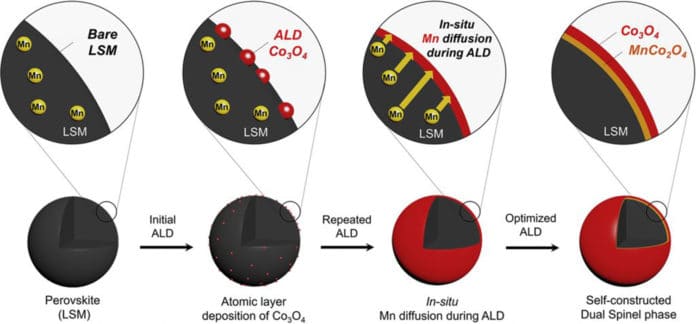Scientists at the UNIST have devised a new catalyst to boost Metal-Air Batteries (MABs) performance, such as discharge and charge efficiency. This new composite catalyst is a form of a very thin layer of metal oxide films deposited on a surface of perovskite catalysts, and thus the interface naturally formed between the two catalysts enhances the overall performance and stability of the new catalyst.
Metal-Air Batteries (MABs), which use oxygen from ambient air as recourses to store and convert energy, have received considerable attention for their potential use in electric vehicles (EVs) owing to their large storage capacity, lightweight, and affordability.
They are equipped with anodes made up of pure metals (i.e., Lithium, Zinc, Magnesium, and Aluminum) and an air cathode that is connected to an inexhaustible source of air. Due to their high theoretical energy density, MABs have been considered a strong candidate for the next-generation electric vehicles. The currently existing MABs use rare and expensive metal catalysts for their air electrodes, such as platinum (Pt).
Arim Seong (Combined M.S/Ph.D. of Energy and Chemical Engineering, UNIST), the first author of the study said, “During the repeated deposition and oxidation cycles of atomic layer deposition (ALD) process, the Mn cations diffuse into Co3O4 from LSM, and therefore, the LSM-20-Co catalyst is composed of LSM encapsulated with the self-reconstructed spinel interlayer (Co3O4/MnCo32O4/LSM).”
“And this has enhanced the catalytic activity of the hybrid catalyst, LSM-20-Co, leading to superior bifunctional electrochemical performances for the ORR and the OER in alkaline solutions.”
“To the best of our knowledge, this is the first study to investigate the self-reconstructed interlayer induced by the in-situ cation diffusion during ALD process for designing an efficient and stable bifunctional catalyst for alkaline zinc-air batteries.”
Professor Guntae Kim, in the School of Energy and Chemical Engineering at UNIST, said, “Our findings provide the rationale design strategy of self-reconstructed interlayer for efficient electro-catalyst. Therefore, this work can provide insight into the rational design strategy of metal oxide with perovskite materials.”
This research has been carried out in collaboration with Professor Raymond J. Gorte (University of Pennsylvania), Professor John M. Vohs (University of Pennsylvania), and Professor Hu Young Jeong (UNIST). The findings of this research have been published in the online version of Nano Energy on February 3, 2020. This work has been supported by the Global Ph.D. Fellowship Program of NRF Grant funded by the Korean Ministry of Science and ICT (MSIT). Also, it has been supported by the Korea Institute of Energy Technology Evaluation and Planning (KETEP) and the Korean Ministry of Trade, Industry & Energy (MOTIE).
